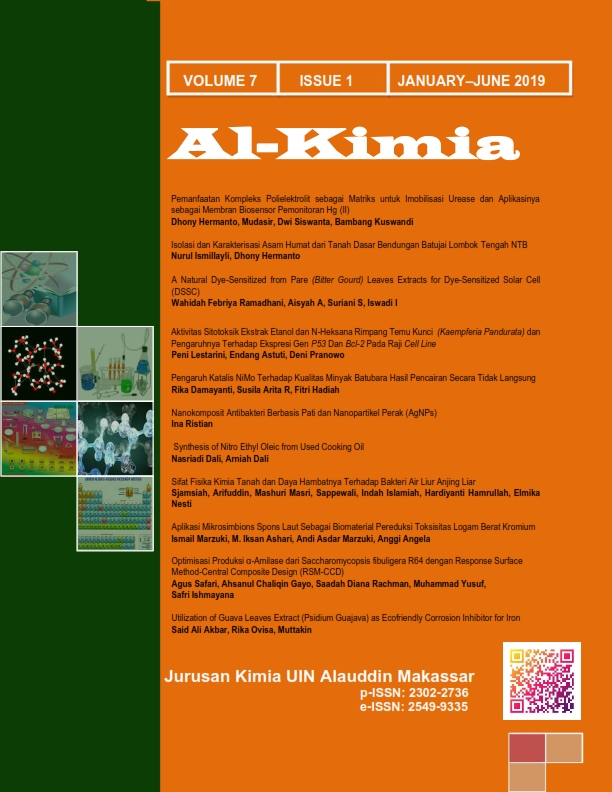A Natural Dye-Sensitized from Pare (Bitter Gourd) Leaves Extracts for Dye-Sensitized Solar Cell (Dssc)
Abstract
The availability of energy sources is dwindling so a renewable energy which has a potential chance to be developed, such as solar panels, is needed. The use of solar panels is still quite expensive in terms of manufacturing process. For this reason, a cheap solar panel based is developed, and it is called DSSC (Dye-Sensitized Solar Cell). The use of DSSC is developed in Indonesia, a country which is famous for its biological richness. In this study, pare leaves were used as photosensitizers obtained from the extraction process of maceration by various solvents. The DSSC test was done on four extracts including N-hexane extract, Ethyl Acetate, Methanol, and Combination of the three extracts. The highest value of efficiency obtained from each extract respectively are 0,03%, 0,04%, 0,14% and 0,30%. Characterization was done by examining the UV-Vis and FTIR spectral data. The result of UV-Vis analysis shows that wavelength for N-hexane, Ethyl Acetate, Methanol, and Combined extracts are 269,1 nm, 668,0 nm, 663,9 nm, and 6631 nm, respectively. FTIR results found that the chromophore and auxochrome groups were identified on all four tested extracts, namely; C = C, C = O, -OH, and -C-H groups.
Downloads
References
Al-wani et al. (2016). Dye-Sensitized Solar Cells: Development, Structure,Operation Principles, Electron Kinetics, Characterisation, Syhthesis Materials and Natural Photosensitisers. Elsevier Renewable and Suistainable Energy Review number 65: p. 183-213.
Baharuddin et al. (2016).“Karakterisasi Zat Warna Daun Jati (Tectona grandis) Fraksi Metanol:n-Heksana sebagai Photosensitizer pada Dye Sensitized Solar Cell”. Chimica et Natura Acta 3, number. 1
Bhogaita et al. (2015). Synthesis and Characterization of TiO2 Thin Film For DSSC Prototype. Elsevier Recent Advance in Nano Science amd Technology.
Gratzel M dan Brian O'Regan. (1991). A Low-Cost, High-efficiency Solar Cell Based on Dye-Sensitized Colloidal TiO2 Film. Nature 253, p. 737-739.
Gratzel, M. (2003). Dye-Sensitized Solar Cell. Photochemistry and Photobiological 4,: h. 154-153.
Jitputti, Jaturong, et al. (2008). Synthesis of TiO2 Nanotubes Photocatalitycal Activity for H2 Evolution. Japanese Journal of Applied Physic 47, number. 8.
Liun, Edward. (2013). Potensi Energi Alternatif dalam Sistem Kelistrikan Indonesia. Pusat Pengembangan Energi Nuklir-BATAN, ISSN. 1979-1208: p. 311-322.
Li, Longwei, et al. (2015). Synthesis of Dispersed Long Single-Crystalline TiO2 Paste and its Application in DSSC as a Scattering Layer. Springer Volume 58, p. 1501-1507.
Maddu, Akhiruddin, et al. (2007). Penggunaan Ekstrak Antosianin Kol Merah Sebagai Fotosensitizer pada Sel Surya TiO2 Nanokristal yang Tersensitasi Dye. Makara, Teknologi 11, number. 2: p. 78-84.
Maurya, Ishwar Chandra et al. (2016). Dye-Sensitized Solar Cell Using From Petals of Male Flowers Luffa cylindrical L. As a Natural Sensitizer. Elsevier Optical Materials 52.
Mutiara, Erlita Verdia dan Achmad Wildan. (2014). Ekstraksi Flavonoid dari Daun Pare Berbantu Gelombang Mikro Sebagai Penurun Kadar Glukosa Secara Invitro. Metana 10, number. 1: p. 1-11.
Pan Xu, et al. (2013). Ionic Liquid Crystal-Based Electrolyte with Enhanced Charge Transport for DSSC". Science China Chemistry Volume 56, p. 1463-1469.
Radwan, Islam Mahmoud. (2015). Dye-Sensitized Solar Cells Based on Natural Dye Extracted From Plant Roots". Skripsi. Palestina: Islamic University of Gaza
Ridwan, M. A, et al. (2018). Fabrication of Dye Sensitized Solar Cell Using Chlorophylls Pigment From Sargassum. IOP Conf. Series: Earth and Envirotment Science Volume 144. Doi:10.1088/1777-1315/144/1/010239.
Richhariya, Geetam et al. (2017). Natural Dyes For Dye Sensitized Solar Cell: A Review. Elsivier Renewable and Sistainable Energy Review 69.
Ren, Y, et al. (2001). A Dye-Sensitized Nanoporous TiO2 Photoelectrochemical with Novel Gel Network Polymer Electrolyte. Applied Electrochemistry 31: p. 445-447.
Reza, Ghiasi, Mahbobeh Manoochehri, dan Reihaneh Lavasani. (2016). DFTI and TD-DFT Study of Benzene and Borazines Containing Chromophores for DSSC Materials. Russian Journal of Inorganic Chemistry Volume 61,: p. 1267-1273.
Silverstain, Robert, Francis X. Webster dan David J. Kiemele. 2009. Spectrometric Identification of Organic Compounds.
Subramania, A, et al. (2013). Effect of Different Composition of Ethylene Carbonate and Propylene Carbonate Containing Iodide/Triiodide Redox Electrolyte on the Photovoltaic Performance of DSSC". Ionic Volume 19, p. 1649-1653.
Suprianto. (2016). Potensi Daun Biduri (Calotropis gigantae) Sebagai Bahan Aktif Dye Sensitized Solar Cell (DSSC). Natural Science 5, number. 2, ISSN. 2338-0950, p. 132-139.
Trianiza, Ice dan Gatut Yudoyono. (2012). Fabrikasi DSSC Dengan Teknik Pelapisan Spin Coating Menggunakan Kaca ITO dan FTO Sebagai Substratdan Variasi Jahe Merah (ZingiberOfficinaleVar Rubrum) Sebagai Dye Sentizer”. Jurusan Fisika Fakultas IPA Institut Teknologi Sepuluh Nopember: p. 1-8.
Zahrok, zid Latifataz dan Gotjang Prajitno. (2015). Ekstrak Buah Murberi sebagai Sensitizer Alami Dye-Sensitized Solar Cell (DSSC) menggunakan Substrat Kaca ITO dengan Teknik Pelapisan Spin Coating. Sains dan Seni ITS 4, number. 1 p. 26-31
Copyright (c) 2019 Wahidah Febriya Ramadhani, Aisyah A, Suriani S, Iswadi I

This work is licensed under a Creative Commons Attribution-NonCommercial-ShareAlike 4.0 International License.
Authors who publish with this journal agree to the following terms:
1) Authors retain copyright and grant the journal right of first publication with the work simultaneously licensed under a Creative Commons Attribution License that allows others to share the work with an acknowledgement of the work's authorship and initial publication in this journal.
2) Authors are able to enter into separate, additional contractual arrangements for the non-exclusive distribution of the journal's published version of the work (e.g., post it to an institutional repository or publish it in a book), with an acknowledgement of its initial publication in this journal.
3)Authors are permitted and encouraged to post their work online (e.g., in institutional repositories or on their website) prior to and during the submission process, as it can lead to productive exchanges, as well as earlier and greater citation of published work (See The Effect of Open Access).


